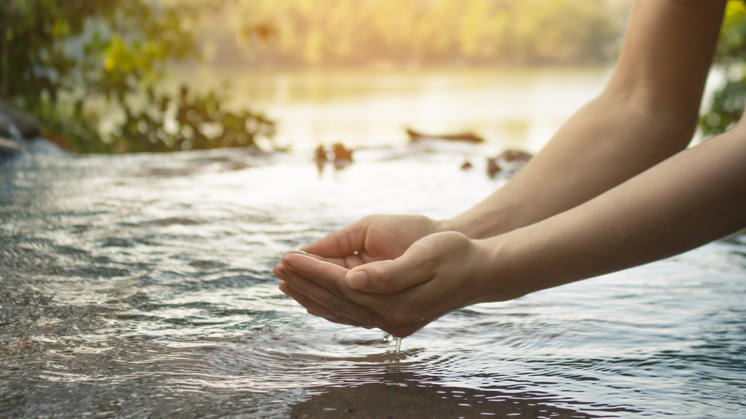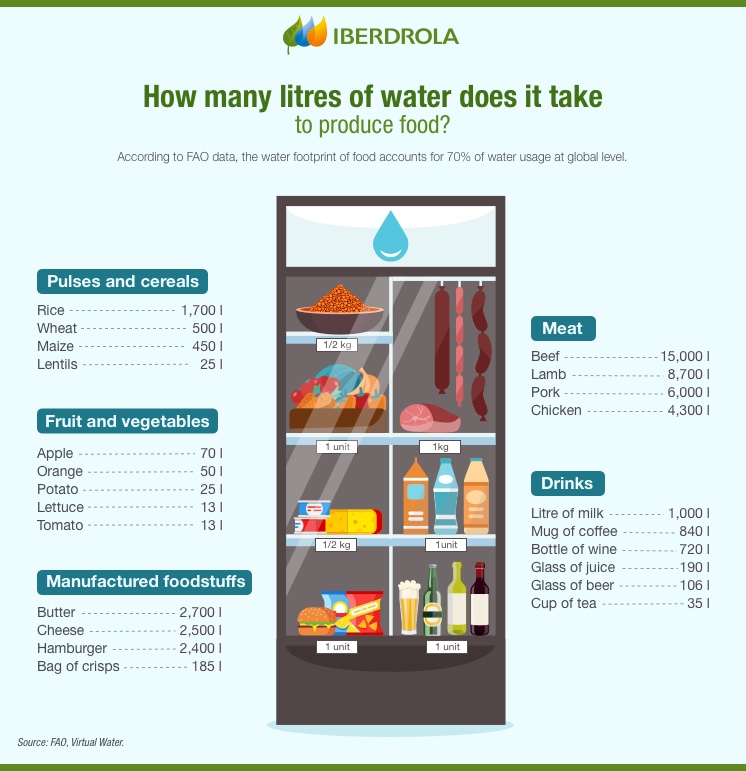What is water footprint
The water footprint, the key to preserving a vital natural resource
To produce a litre of milk, according to the United Nations Organisation for Food and Agriculture (FAO), it takes 1,000 litres of water. Who doesn't consume a tetra brik a day? We know this fact thanks to the water footprint, a concept that measures the consumption of water for goods or services. Its aim is to raise awareness about its rational use, especially now that it is in short supply due to climate change and population increase.

The products we use, the clothes we wear and the food we eat need water for their manufacture or production. The World Health Organisation (WHO) reckons, for instance, that in a daily routine like a 10 minute shower we use 200 litres of water. As a result of this and other activities, each person consumes on average 1,385 m3 of water a year, according to global benchmarking studies carried out by Arjen Hoekstra and Mesfin Mekonnen.
These figures raise the question: can the human race carry on consuming so much water? It's worth remembering that this resource, something on which all life on earth depends, is becoming increasingly scarce due to climate change, water pollution and population increase, which the UN tells us will be approaching 10 billion people by 2050.
What is the water footprint and what is it used for
Rather like the carbon footprint, the water footprint is an environmental indicator that measures the volume of fresh water (in litres or cubic metres) used throughout the entire production chain of a consumer item or service. It can be used to measure the consumption of water for practically anything - from the manufacture of a pair of trousers to the entire consumption of a country, including for example a harvest, or a company's annual activities.
The concept of the "water footprint" was conceived in 2002 by Arjen Hoekstra while he was working at the IHE Delft Institute for Water Education (UNESCO-IHE). Later, in 2008, due to growing interest from industry in the water footprint, he founded the Water Footprint Network together with leading figures from the business world, the public and academia. In general terms, the objective of the water footprint is to create awareness about the huge volume of water that our production processes and lifestyles require, with the aim of promoting rational and sustainable use.
Types of water footprint
According to the Water Footprint Network, a water footprint is made up of three things depending on where the water comes from:
- Green water footprint: is water from precipitation (rain or snow) that is stored in the root zone of the soil and evaporated, transpired or incorporated by plants. It is particularly relevant for agricultural, horticultural and forestry products.
- Blue water footprint: is water that has been sourced from surface or groundwater resources and is either evaporated, incorporated into a product or tipped into the sea. Irrigated agriculture, industry and domestic water use can each have a blue water footprint.
- Grey water footprint: is the amount of fresh water required to assimilate pollutants in the production process to meet water quality standards.
How is the water footprint measured
The water footprint, for example, of a country is measured through four factors as follows:
Total consumption volume
There is, of course a correlation between the Gross Domestic Product (GDP) of a country and its water footprint. The greater the GDP, the bigger the water footprint.
Consumption patterns
Consumption habits in a country condition its water footprint, especially the consumption of items that require a large amount of water for their production.
Climate
In countries with high temperatures, and therefore, greater evaporation demand, crops need more water.
Agricultural practices
Countries with low agricultural performance because of inefficiencies — like Thailand or Mali, for instance — have high water footprints.
Work out your own personal water footprint through the Water Footprint Network

The global water situation
According to the latest data from the Water Footprint Network, the countries with the biggest water footprint in the world per capita are: Mongolia, with 10,000 litres of water per day per person; Niger, with 9,600; Bolivia, with 9,500; United Arab Emirates, with 8,600, and the United States, with 7,800. In terms of absolute statistics, the ranking is led by the most populated countries: China, with a consumption of 1,400,000 million cubic metres of water per year (16% of the world's water footprint), followed by India with 1,100,000 million (13%).

SEE INFOGRAPHIC: How many litres of water does it take to produce food? [PDF]
Tips to reduce water footprint
Some of the little things we can do to reduce our water footprint as consumers are:
- Reduce showering time, turn the water off while we're applying soap and use ecological shower heads.
- Aim to eat sustainable food and cut consumption of those foods that require more water, like meat.
- Support sustainable and local agriculture, cattle-production and fishing.
- Opt for responsible consumption and the circular economy.
Elsewhere, as regards business activity the following are recommended:
- Implement an environmental quality system.
- Encourage recycling, reuse and ecological consumption at the heart of the company.
- Use suppliers who are committed to reducing the water footprint.
- Digitalise as far as possible to save paper, for instance (paperless offices).




